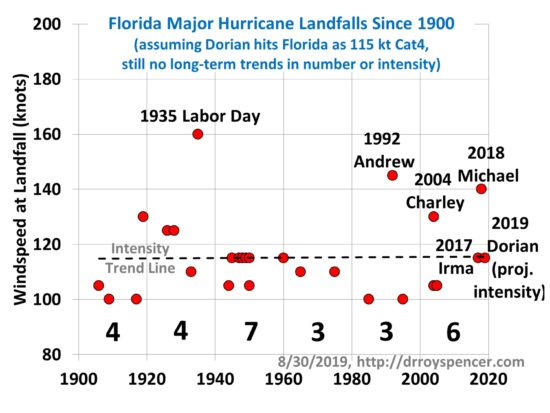NOTE: This post was updated on 30 August to include Hurricane Michael (2018).
Atlantic hurricane activity is notoriously variable, not only from year to year, but decade to decade.
In fact, based upon studies of overwash sediments in coastal lakes stretching from the Florida panhandle to eastern Louisiana, it appears that the period from 1,000 to 3,800 years ago had a considerably higher incidence of Category 4 & 5 hurricanes than in the last 1,000 years. These are admittedly indirect, proxy estimates, but if you read this American Scientist article, it sounds like the researchers have pretty strong evidence.
Why would major hurricane activity vary so much? No one knows. Our climate is a nonlinear dynamical system, capable of undergoing unforced changes both locally and globally. Atmospheric steering currents, wind shear, and African easterly wave activity all play a role in hurricane formation. Tropical Atlantic sea surface temperatures (SSTs) in the late summer are always sufficiently warm to support a major hurricane and are, in my opinion, overrated as a controlling factor. Factors other than SST tend to largely determine hurricane activity and strength.
More direct measurements of hurricane landfalls in Florida have only been possible in the last 120 years or so since prior to 1900 very few people lived there. Before 1900, the intensities of these storms at landfall were quite uncertain. It could be some even went unreported.
If we examine the record of major (Category 3 or greater) hurricanes at landfall in Florida since 1900, and assume that Hurricane Dorian strikes Florida as a 115 kt Category 4 storm, we see that there will still be no long-term trends in either the intensity or number of major landfalling hurricanes.

If Hurricane Dorian makes landfall in Florida as a 115 kt Category 4 storm, there will still be no long term trend in Florida major hurricane landfalls since 1900.
This is not to say there won’t be potentially catastrophic damage. For example, the population of Miami in 1900 was less than 1,700 people. It is now 2.74 million. Needless to say, vast expanses of storm-vulnerable infrastructure has been built over the last 120 years across the Miami-Ft. Lauderdale-West Palm Beach metroplex, and northward along most of the Florida coastline.
But increasing storm damage does not mean increasing storminess.

 Home/Blog
Home/Blog



